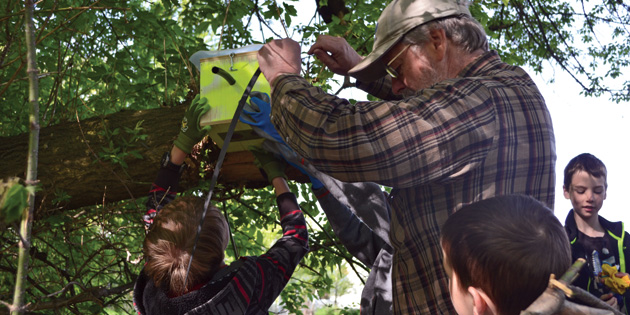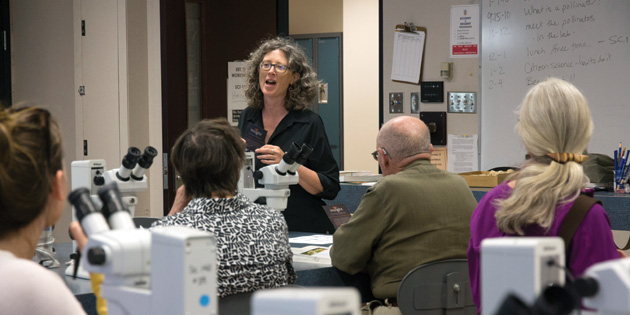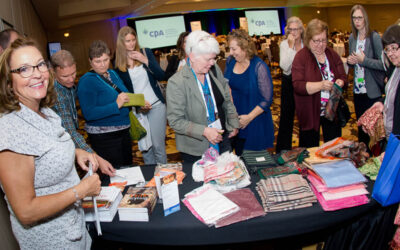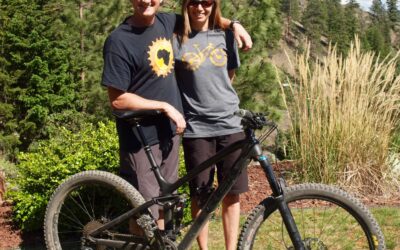Educator/artist Nancy Holmes is the co-founder of the Border Free Bees project; see what you can do
A swarm of kindergarten kids is buzzing through the field, their excitement contagious.
“I’ve found a bee,” shouts one.
I don’t know if I’ve ever heard that phrase said with such genuine joy. But these kids aren’t here to goof around on a school trip; they’re here to plant the milkweed they’ve been growing all year—a favourite of local bees. And in doing so, these kids are actually playing a key role in helping to save Kelowna’s wild bees.
The “queen bee” behind all of this is Dr. Nancy Holmes. She greets me with a level of enthusiasm that catches me a little off guard—seeing as how she’s spent her morning toiling in a hot meadow garden while watching 30 or so young children. Holmes is the co-founder, along with Dr Cameron Cartiere of Emily Carr University, of the Border Free Bees project; an interactive partnership involving volunteers from the public and both the local artistic and scientific communities for the purpose of restoring wild bee populations.
You’ve no doubt heard about this problem: around the world bees are dying at an ever accelerating rate. One of the key reasons is habitat loss. Quite simply, the bees are losing the pastures they pollinate and the places they nest. This is where the most visible component of the Border Free Bees project comes into play, the Public Art Pollinator Pasture in Kelowna’s Mill Creek City Park. Nancy and a small army of volunteers are stripping the meadow of invasive species and planting native plants that are favourites of local bees. Holmes is helping to oversee such projects here in Kelowna while her partner oversees the effort in Richmond. Together, they are creating a welcoming place of refuge for both endangered bees and the public.
While you might expect a scientist to be spearheading this project, Holmes is actually a professor of creative writing at UBC’s Okanagan campus. She’s also an artist and poet whose work for the last 12 years has been inspired by the Okanagan environment, so her commitment to this issue is no surprise. Nor is this her first major project involving the environment.
In 2010 Holmes helped to establish the Eco-Art Incubator programme at UBC. This was an initiative to provide financial and professional support to artists whose works were geared towards the local environment. In only five years this programme helped support more than 25 artistic endeavours right here in the Okanagan.
When asked how she became involved with Border Free Bees, her response was humble. “Cam went to see a lecture by Dr. Elizabeth Elle, a renown bee biologist, and was so moved she called me up and roped me into this project,” she says, adding (as if feeling more justification was needed), “It’s an important project.”
And it is. While no one likes to invite a swarm of bees into their neighbourhood, bees play a critical role in agriculture. They not only provide us with honey, but pollinate the plants we use to produce everything from fruit to vanilla ice cream. And while much of the spotlight has been put on honey bees, Holmes says that 70 to 75 per cent of all pollination is actually done by native, wild bees rather than the more iconic honey bee. Yet here in the BC Interior, almost 25 per cent of our native bee species are facing the very real possibility of extinction.
Holmes laughs and nods her head as one of her volunteers reminisces about how difficult it was to get used to working with “bugs.” But she stresses the importance of keeping a healthy wild bee population in our community. Holmes’ ultimate hope is that these pastures will attract just as many volunteers as bees. Her belief is that wild bees make up a key component of our agricultural community here in the Okanagan. Her hope is that the Pollinating Pastures will help to “change how we think of the landscape” and encourage people to plant pollinator-friendly gardens, shying away from conifers and hedges in exchange for more local flowering plants.
Volunteers of all backgrounds (and ages) are welcome to help the Border Free Bees project. Visit the project’s website (borderfreebees.com) for information on how to get involved.
By Blake Allen
Continue reading below for tips on how to make your own DIY bee home!

DIY Bee Home
Mason bees (a.k.a. blue orchard bees) nest in tubes, not hives
Container: You can use many things to house your mason bees: a tin can (big one), a waxed milk carton, a brick, a piece of wood with holes* drilled in it (7.5 inches deep), a wooden box that you already have, or you can build a small box. If you use a piece of wood, the best size hole is 1/4 inch, but drill the holes 3/8 inch so your tube fits in. You want the house to be at least 7 inches deep. (Female bees incubate in the back 3-4 inches and males bees incubate in the front 3-4 inches. If your tube is too short your mason bees will not be balanced in terms of gender.)
Weatherproof: The important thing is your house needs to be waterproof and have a roof big enough to cover the front to keep out the wind and rain.
Nesting material: Mason bees are called mason bees because they use mud made of clay and water to line their tubes and separate each laid egg. Dig a little area close to your house down to the clay and make sure there’s water close by so there’s material for this clay-mud tube liner.
Tubes: Once you have a container, you need to make the tubes. Use plain brown paper, that’s the best. (newspaper and other papers have dyes that are not good for bees) Cut strips that are 7 inches long by 2.5-3.5 inches wide. Roll the paper over a regular pencil and tape it closed in a couple places. Make enough so they fit snuggly into your container. A one litre milk carton will need about 30 tubes.
Placement: Now put the tubes in your container. Then, put your container at least 4 feet off the ground facing east (south is too hot for the bees in the Okanagan). Do not put your container in a tree; rather screw it to the side of a garden shed, house, fence or similar regular-shaped, broad, flat surface. You want to make it easy for the bees to find their home when they are flying fast. Make sure it is stable and doesn’t swing around in the wind. *If you drilled holes in a piece of wood make sure the holes are a little longer than your tube, there needs to be a “back” at the end of the tube to block light—tubes are open on one end only.
As seen in:
[downloads ids=”135707″ columns=”1″]





0 Comments